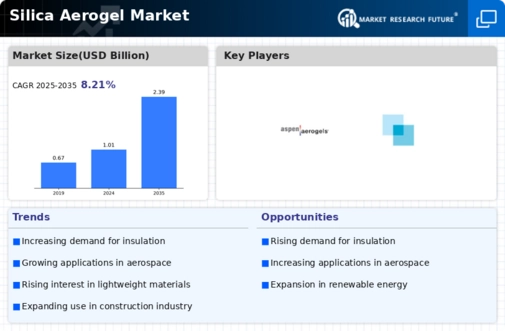Top Industry Leaders in the Silica Aerogel Market

Silica aerogel, a wonder material boasting phenomenal insulation, low density, and unique optical properties. From aerospace components to building insulation, this ethereal material finds its rhythm across diverse industries, but beneath the surface dances a complex competitive landscape. Let's delve into the strategies, factors impacting market share, and the latest developments in this captivating market.
Competitive Strategies Shaping the Arena:
-
Industry Leaders: Aspen Aerogels, Cabot Corporation, BASF, and Nano High-Tech leverage their established production capacities, diverse product portfolios, and global reach to maintain their leading positions. Their strategies focus on continuous R&D for improved aerogel properties, strategic acquisitions, and partnerships with major end-use manufacturers. -
Regional Champions: Companies like China National Building Materials and Guizhou Aerospace hold strong positions in their respective regions. They capitalize on cost-effective production, cater to regional preferences, and build robust local distribution networks. -
Niche Innovators: Emerging players like Aerogel Technologies and Enersens carve niches with specialized aerogel applications like cryogenic insulation or acoustic dampening. They capitalize on unique technology and cater to specific customer segments, often commanding premium prices.
Factors Dictating the Market Share Waltz:
-
Technological Advancements and Performance: Developing aerogels with improved thermal insulation, fire resistance, mechanical strength, and optical properties attracts wider customer segments and expands market share. Continuous R&D is crucial for staying ahead of the curve. -
Production Cost and Scalability: Optimizing production processes, sourcing raw materials cost-effectively, and achieving higher production volumes are essential for driving down prices and gaining market share, particularly in price-sensitive sectors. -
Application Diversification and Customer Targeting: Offering aerogel solutions for diverse applications like building insulation, aerospace components, oil and gas pipelines, and even clothing caters to various industries and expands market reach. -
Sustainability and Environmental Impact: Adhering to environmental regulations and developing eco-friendly aerogel production processes and bio-based raw materials addresses green concerns and opens doors to new markets. -
Regulatory Landscape and Government Initiatives: Government policies promoting energy efficiency, eco-friendly materials, and aerospace advancements can significantly impact market growth and create opportunities for specific players.
Key Players:
- BASF SE (Germany)
- Aspen Aerogels Inc. (U.S)
- Cabot Corporation (U.S.)
- Ocellus Inc (U.S.)
- Aerogel Technologies (U.S.)
- JIOS Aerogel Corporation (Korea)
- Svenska Aerogel Holding AB (Sweden)
- F. Technologies (U.S.)
- The Dow Chemical Company (U.S.)
Recent Developments:
-
September 2023: Nano High-Tech partners with a leading textile manufacturer to develop aerogel-infused clothing for extreme weather conditions and enhanced thermal comfort. -
October 2023: Enersens announces plans for a new production facility in India, aiming to cater to the growing demand for aerogel insulation in the region's construction sector. -
November 2023: A team of researchers at MIT develops a novel, energy-efficient method for producing aerogel, potentially disrupting traditional production processes and reducing costs. -
December 2023: The US Department of Energy awards grants to two startups developing innovative aerogel applications for energy storage and solar energy technologies.

